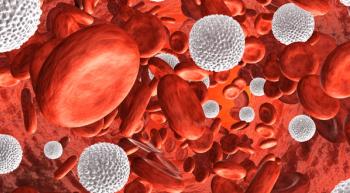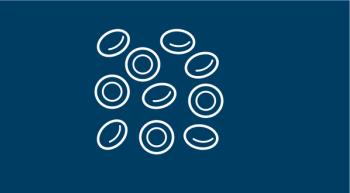
CPX-351 Continues to Improve Survival in Older Patients With AML

Data from a 5-year follow-up study confirmed that CPX-351 continues to be associated with long-term remission and improved overall survival compared to 7+3 chemotherapy in certain older patients with acute myeloid leukemia.
Findings from a 5-year analysis of a phase 3 trial (NCT01696084) demonstrated that older patients with newly diagnosed high-risk or secondary acute myeloid leukemia (AML) continued to achieve improved overall survival (OS) with treatment with the fixed combination of daunorubicin and cytarabine (CPX-251; Vyxeos) compared to 7+3 chemotherapy.
Between December 20, 2012, and November 11, 2014, 309 patients with newly diagnosed high-risk or secondary AML were enrolled and randomized to receive CPX-351 (n = 153) or 7+3 (n = 156). At a median follow-up of 60.91 months (Interquartile range [IQR], 60.06-62.98) in the CPX-351 arm and 59.93 months (IQR, 59.73-60.50) in the 7+3 arm, the median OS was 9.33 months (95% CI, 6.37-11.86) with CPX-351 vs 5.95 months (95% CI, 4.99-7.75) with 7+3 (HR, 0.70; 95% CI, 0.55-0.91).
“After 5 years of follow-up, the improved OS with CPX-351 vs 7+3 was maintained, which supports the previous evidence that CPX-351 can contribute to long-term remission and improved OS in patients aged 60 to 75 years with newly diagnosed high-risk or secondary AML,” wrote lead study author Jeffrey E. Lancet, MD, of Moffitt Cancer Center, and coauthors in the study publication.
CPX-351 is given as standard induction therapy for patients with AML; the agent comprises a dual-drug liposomal encapsulation of daunorubicin and cytarabine in a 1:5 molar ratio.
Primary findings from the phase 3 trial (NCT01696084) supported the 2017 FDA approval of the fixed combination in patients 60 to 75 years of age with newly diagnosed high-risk or secondary AML.
Eligible patients included those aged 60 to 75 years who had a pathological diagnosis of AML according to the World Health Organization 2008 criteria, no previous induction therapy for AML, and an ECOG performance status of 0 to 2.
Patients were randomized to receive up to 2 induction cycles of CPX-351 at a dose of 100 units/m2 over a 90-minute intravenous (IV) infusion on days 1, 3, and 5; on days 1 and 3 for the second induction, or standard 7+3 chemotherapy, consisting of 100 mg/m2 of cytarabine daily in a continuous IV infusion for 7 days plus IV daunorubicin at a dose of 60 mg/m2 on days 1, 2, and 3; cytarabine for 5 days and daunorubicin on days 1 and 2 for the second induction (5+2).
Patients with complete remission (CR) or complete remission with incomplete neutrophil or platelet recovery (CRi) could receive up to 2 cycles of consolidation therapy with CPX-351 at a dose of 65 units/m2 over a 90-minute infusion on days 1 and 3 or 5+2 chemotherapy.
OS served as the primary end point.
Additional results demonstrated favorable 3- and 5-year OS estimates. The 3-year OS rate was 21% with CPX-351 (95% CI, 15%-28%) vs 9% with 7+3 (95% CI, 5%-14%). The 5-year OS estimate was 18% (95% CI, 12%-25%) in the CPX-351 arm vs 8% (95% CI, 4%-13%) in the 7+3 arm.
In a multivariable analysis, better ECOG performance status, favorable- or intermediate-risk karyotype, lower white blood cell count, higher platelet count, and CPX-351 therapy was associated with improved OS.
When analyzed by age subgroup, the median OS and 3-year and 5-year OS rates favored the use of CPX-351 in patients aged 60 to 69 years and 70 to 75 years. In those aged 60 to 69 years old, the median OS was 9.59 months (95% CI, 6.01-12.62) with CPX-351 and 6.87 months (95% CI, 4.63-8.84) with 7+3 chemotherapy (HR, 0.73; 95% CI, 0.54-0.99). For patients between the ages of 70 to 75 years old, the median OS was 8.87 months (95% CI, 4.73-12.19) and 5.62 months (95% CI, 3.29-7.52), respectively (HR, 0.52; 95% CI, 0.34-0.77).
In patients who underwent transplant, the median OS from the date of transplant was not reached (95% CI 16.23–not estimable) for CPX-351 vs 10.25 months (95% CI, 6.21-16.69) for 7+3 (HR 0.51; 95% CI, 0.28-0.90). At 3 years, the OS rate from the date of transplant was 56% (95% CI, 42%-68%) for CPX-351 vs 23% (95% CI, 11%-37%) for 7+3.
CR/CRi was reported in 48% of patients (n = 73 of 153) in the CPX-351 arm vs 33% of patients (n = 52 of 156) in the 7+3 arm. The median OS in patients with CR/CRi was 21.72 months (95% CI, 13.01-29.70) in patients who received CPX-351 vs 10.41 months (95% CI, 7.82-15.21) in patients who received 7+3 (HR 0.59; 95% CI, 0.39-0.88).
No additional adverse effects were identified with long-term follow-up, apart from death related data. The most common cause of death in both arms was progressive leukemia (n = 70; 56% of 124 deaths in the CPX-351 arm vs n = 74; 53% of 140 deaths in the 7+3 arm). Six (5%) of 124 deaths in the CPX-351 arm vs 7 (5%) of 140 deaths in the 7+3 arm were treated related.
Causes of death that were potentially related to study treatment were sepsis (n = 2), cerebral hemorrhage (n = 2), multiorgan failure (n = 1), and pneumonia (n = 1) in the CPX-351 arm vs respiratory failure (n = 2), sepsis (n = 1), pulmonary hemorrhage (n = 1), brain hemorrhage (n = 1), cardiac arrest (n = 1), and multiorgan failure (n = 1) in the 7+3 arm.
Reference
- Lancet JE, Uy GL, Newell LF, et al. CPX-351 versus 7+3 cytarabine and daunorubicin chemotherapy in older adults with newly diagnosed high-risk or secondary acute myeloid leukaemia: 5-year results of a randomised, open-label, multicentre, phase 3 trial. Lancet Haematol. 2021;8(7):E481-E491. doi:10.1016/S2352-3026(21)00134-
Newsletter
Knowledge is power. Don’t miss the most recent breakthroughs in cancer care.

















































































